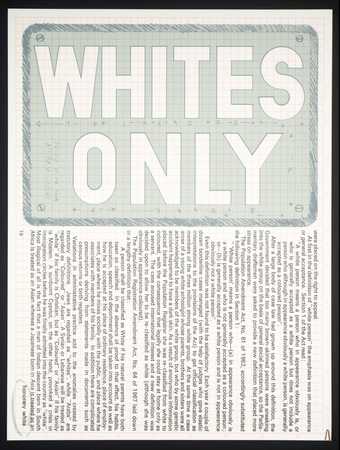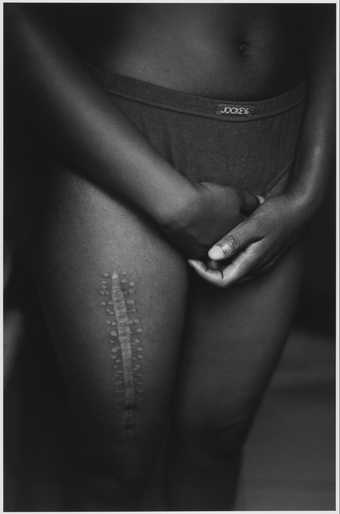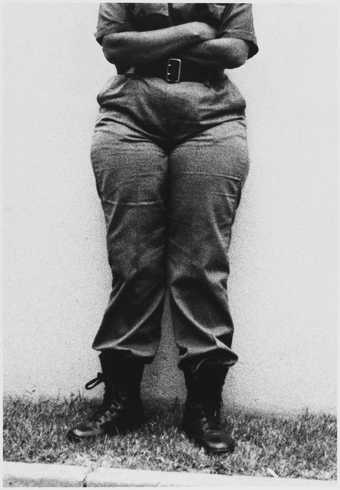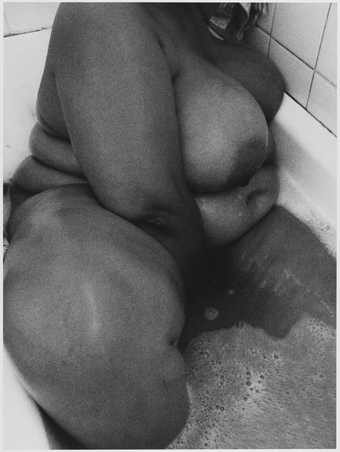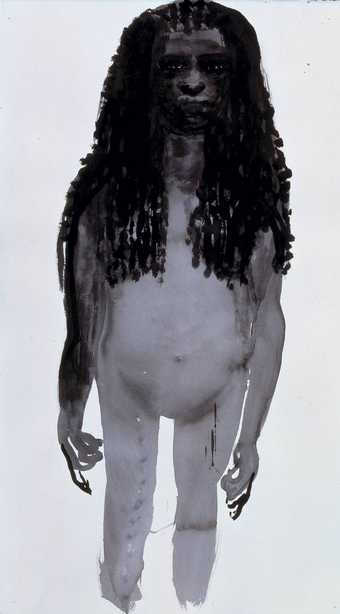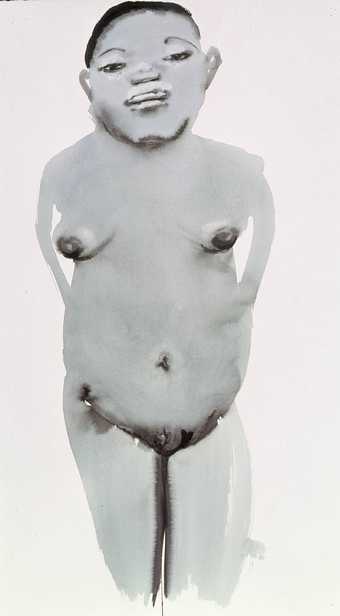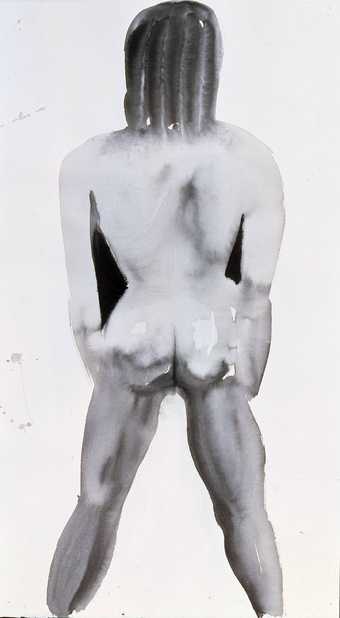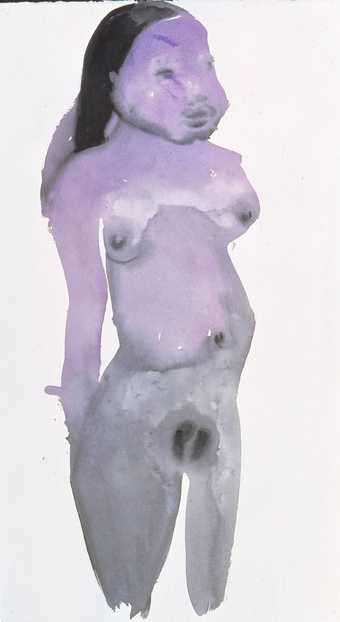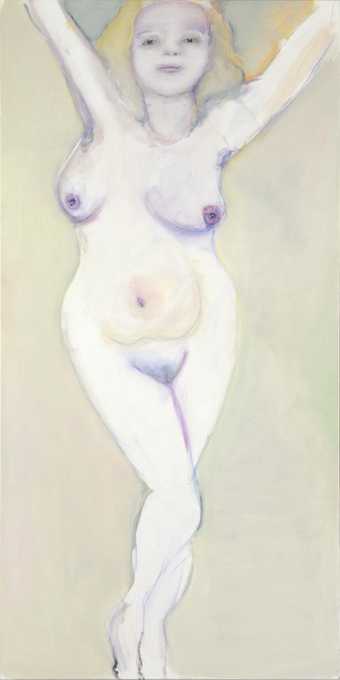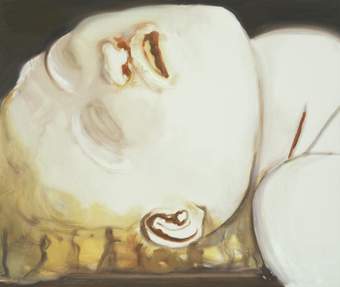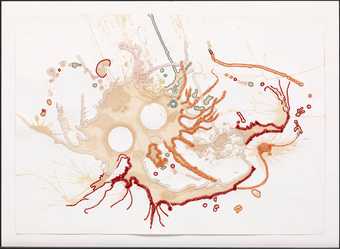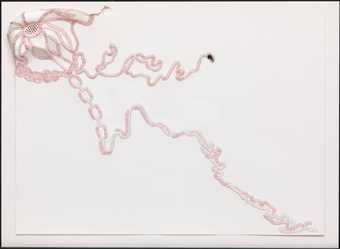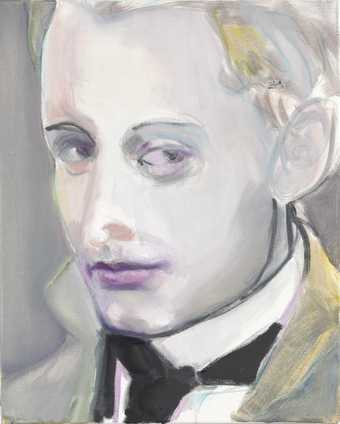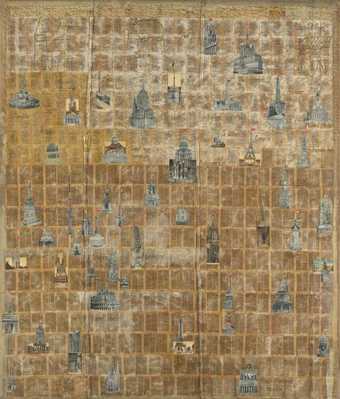
Not on display
- Artist
- Marlene Dumas born 1953
- Medium
- Ink on paper
- Dimensions
- Image: 1250 × 700 mm
frame: 1339 × 789 × 40 mm - Collection
- Tate
- Acquisition
- Purchased 1996
- Reference
- T07206
Summary
This text discusses six works on paper (T07201-T07206) which are part of a larger group conceived as an open-ended series.
Dumas began work on the Magdalena paintings after completing a series of portrait heads of Jesus, entitled Jesus Serene. In these, the artist explored the theme of desire, in relation to an unobtainable but longed-for object. The next step, the series of works based on the Biblical character Mary Magdalene, was, Dumas felt, 'easy, even logical'. She continued: 'I called them only "Magdalena" to make them less historically religious. I also liked the fact that this woman wants this man and he says "no". My men are often supposedly "feminine" while my women are more "masculine" (if you want to use these distinctions still). I believe in love stories, the gender of the lover does not matter in the end. I use religious subjects as I use fairy-tale figures, in order to give my audience an easy starting point, a popular reverence that relates to all times and that is familiar to most people.' (quoted in Catherine Kinley, Marlene Dumas, exhibition broadsheet, Tate Gallery 1996)
The Magdalena portraits also relate to an earlier series of large paintings of women which the artist exhibited in Venice in 1995. In these earlier works Dumas combined images of the model Naomi Campbell taken from fashion photographs, with Flemish depictions of the repentant Mary Magdalene, her naked body concealed beneath long hair. The fusion of such strongly contrasting imagery is a significant aspect of Dumas' working process, although she usually disguises her sources. The artist writes: 'I do treat my faces with a certain equality. In them the "sane" look a bit crazy, the crazy look a bit sane and everybody is trying to seduce you in some way or another...[In my work] I use all the cheap tricks of attracting attention; eyes looking at you, sexual parts exposed or deliberately covered... the primitive pull of recognition; the image as prostitute. You are forced to say "yes" or "no"'. (ibid.)
In the Magdalena series, as with the paintings of Naomi Campbell, Dumas depicts the human form naked. Dumas uses nakedness to explore themes of love and fear, of intimacy and distance. She stresses that her intentions are not at all voyeuristic. By placing what is generally regarded as a private image of a naked form into the realms of public experience, she makes her subjects appear vulnerable and isolated. However, she feels a strong connection with her subjects and believes that the viewer, once he or she confronts these images, will feel as vulnerable.
Further reading:
Catherine Kinley, Marlene Dumas, exhibition broadsheet, Tate Gallery 1996
Mary Horlock
11 June 1996
Does this text contain inaccurate information or language that you feel we should improve or change? We would like to hear from you.
Display caption
The Magdalena portraits relate to a series of paintings that Dumas exhibited in Venice in 1995. In these earlier works, the artist combined images of the model Naomi Campbell taken from fashion photographs, with Flemish depictions of the repentant Mary Magdalen, her naked body concealed beneath long hair. The fusion of such strongly contrasting imagery is a significant aspect of Dumas' working process. 'I use religious subjects as I use fairy-tale figures, in order to give my audience an easy starting point, a popular reference that relates to all times and that is familiar to most people', Dumas has explained.
Gallery label, August 2004
Does this text contain inaccurate information or language that you feel we should improve or change? We would like to hear from you.
Technique and condition
The following entry discusses six paintings by Marlene Dumas, T07201-T07206
Painted on Verlin Arches white cotton fibre wove paper (400gsm). This mouldmade paper has two natural deckle edges. There are pin holes in the four corners of each work where it has been pinned to the wall for display purposes.
The images were painted in Indian ink, thinned with water which was brushed on in washes and then built up in areas with less dilute ink applications. The paper was rubbed vigorously in places while the ink was still wet with either a sponge or paper towel, causing some abrasion to the surface. The paintings were worked flat on the floor and completed in one session.
The paintings are in good condition with slight cockling occuring in some of the images where the ink washes have been applied.
Jo Crook
June 1997
Explore
- emotions, concepts and ideas(16,416)
-
- emotions and human qualities(5,345)
-
- vulnerability(311)
- actions: postures and motions(9,111)
-
- standing(3,106)
- woman(9,110)
- black(796)
- female(1,681)
- Saints(235)
- social comment(6,584)
-
- race(381)
You might like
-
Gavin Jantjes A South African Colouring Book
1974–5 -
Zanele Muholi Aftermath
2004 -
Zanele Muholi In-security
2003 -
Zanele Muholi Flesh II
2005 -
Marlene Dumas Magdalena 1
1996 -
Marlene Dumas Magdalena 2
1996 -
Marlene Dumas Magdalena 3
1996 -
Marlene Dumas Magdalena 4
1996 -
Marlene Dumas Magdalena 5
1996 -
Marlene Dumas Lead White
1997 -
Marlene Dumas Lucy
2004 -
Nicholas Hlobo Macaleni Iintozomlambo
2010 -
Nicholas Hlobo Ikhonkco
2010 -
Marlene Dumas Lord Alfred Douglas (Bosie)
2016 -
Vivienne Koorland The Local Monuments I: Childhood
1995

